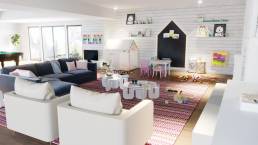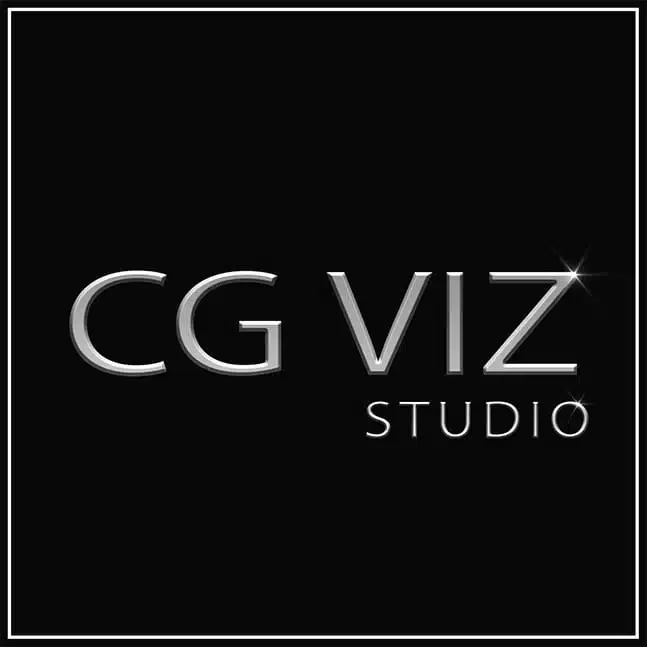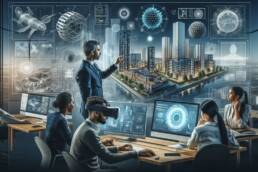Welcome to a world where ‘Empowering Unique Creativity with 3D Visualization in Animated Design’ is more than just a phrase—it’s the gateway to innovation in design. This transformative technology is reshaping how we approach design, architecture, and product development. Through this blog post, we will explore the profound impact of 3D visualization, a tool that has become the lifeblood of creativity for professionals across various industries. From architects to product designers, and marketing gurus, mastering 3D visualization is a must in our digitally driven world. Dive in with us as we navigate through its applications, uncover the benefits it adds to the design process, and look ahead at the emerging trends setting the stage for the future. Get ready to unlock the full potential of your designs with the magic of 3D visualization.
Key Takeaways
- 3D visualization is an essential part of the design process, allowing for effective communication and realistic representation of designs.
- Using 3D visualization in design enhances design communication and improves client engagement.
- 3D visualization has various applications in industries such as architecture, product design, and marketing.
- Challenges in 3D visualization include managing complexity, addressing technical limitations, and ensuring accuracy and realism.
- Future trends in 3D visualization include advancements in virtual reality and augmented reality, integration of artificial intelligence, and emerging techniques for interactive visualization.
Understanding the Basics of 3D Visualization

Understanding the basics of 3D Visualization is essential in today’s digital landscape, where visual representation plays a crucial role. At its core, 3D Visualization is the process of creating graphical content using 3D software. It’s a technique that allows designers and artists to craft a visual representation of an object, concept, or layout in three dimensions, making it an invaluable tool in architecture, gaming, product design, and animation. This technology helps bring ideas to life and enables viewers to visualize complex designs and concepts more tangibly and understandably. The strength of 3D Visualization lies in its ability to create detailed and realistic models that can be observed from any angle, providing a clearer understanding of how a finished product or project will look and function in the real world.
1. The Evolution of 3D Visualization
In the world of design, the evolution of 3D visualization has revolutionized the way we bring ideas to life. With the integration of advanced technology, designers can now create realistic and immersive visualizations that transport us into a world of endless possibilities. Gone are the days of relying solely on 2D drawings or imagining how a project will look in reality. Now, with the click of a button, a vibrant and realistic 3D render can capture every intricate detail and showcase it in stunning detail.
2. Principles of 3D Visualization
In the field of 3D visualization, several key principles guide the creation and implementation of realistic and visually appealing designs. These principles are essential for achieving accurate representations and conveying design concepts effectively. Attention to Detail is a fundamental principle in 3D visualization, as it involves meticulously crafting every aspect of the design to ensure precision and realism. By paying close attention to details such as textures, lighting, and proportions, designers can create immersive and lifelike experiences. Another important principle is Composition, which involves arranging elements within the design to create a visually balanced and aesthetically pleasing composition. This includes considering the placement of objects, the use of color and contrast, and the overall visual flow of the design. Realism is also a key principle in 3D visualization, as it aims to create designs that closely resemble real-world objects and environments. By incorporating realistic textures, materials, and lighting effects, designers can enhance the believability and authenticity of their designs.
3. Tools and Technologies for 3D Visualization
The field of 3D visualization is supported by a wide range of tools and technologies that empower designers to bring their ideas to life. These tools provide a powerful platform for creating and manipulating 3D models, textures, and animations. They offer a diverse set of features that cater to the diverse needs of 3D designers and enthusiasts alike. From mesh manipulation to texture mapping, these tools enable creators to refine existing models or create from scratch with ease. Additionally, animation support allows for the incorporation of dynamic movement, adding an extra layer of realism to projects.
Exploring the Applications of 3D Visualization in Different Industries

1. Architecture and Interior Design:
3D visualization brings architectural and interior designs to life. It allows everyone involved to see the project’s details, ensuring that architects, engineers, and clients are on the same page. It’s also great for trying out bold design ideas, and with services like our Custom 3D Render Service, clients can try different looks and make changes easily, saving time and cost.
2. Product Design and Manufacturing:
Using 3D models, companies can show off their products in a realistic way. This helps customers see what they’re buying before it’s made, especially useful in design and manufacturing. 3D renders look good and feel real, giving businesses a marketing edge. Plus, with CAD software, they can see their product from all sides, which helps in making it just right.
3. Marketing and Advertising:
3D renders are perfect for making marketing materials that stand out. They let businesses show their products in unique ways in ads and online, and they’re also handy for testing out product designs virtually. This means businesses can try out ideas before making anything real, saving money and time. 3D visuals are also great for ads, websites, and social media, helping to draw in customers and boost sales.
Overcoming Challenges in 3D Visualization

1. Simplifying Complex Projects:
For 3D design projects, it’s all about being efficient. The aim is to use smart tools to make workflows smooth and keep the designs accurate. This helps in finishing projects fast and well. AI is a big help here, making designs look super real, which is great for architecture and ads.
2. Solving Tech Challenges:
3D design can get tricky with big, detailed projects. To keep things running smoothly, especially for real-time viewing, we use smart computing tricks. This makes sure everything looks great without slowing down your computer. Plus, adding textures and animations makes designs come to life and tells a better story.
3. Getting Details Right:
Realistic details make 3D designs stand out. Using the right materials and lighting is key to making everything look real. AI helps a lot with this, too. Working together with clients makes sure the final design is just what they want, and using the latest tools makes the job easier.
Future Trends and Innovations in 3D Visualization
1. Advancements in Virtual Reality (VR) and Augmented Reality (AR)
The advancements in Virtual Reality (VR) and Augmented Reality (AR) have revolutionized the field of 3D visualization. These technologies have opened up new possibilities for immersive experiences and enhanced design communication. VR allows designers and clients to fully immerse themselves in a virtual environment, providing a realistic sense of scale and spatial relationships. AR, on the other hand, overlays virtual elements in the real world, allowing designers to visualize and interact with their designs in a real-world context. These technologies have greatly enhanced design communication by enabling stakeholders to better understand and experience the design before it is built. They have also improved client engagement by allowing them to actively participate in the design process and provide feedback in real time.
2. Integration of Artificial Intelligence (AI) in 3D Visualization
The integration of AI in 3D visualization has revolutionized the creative process, allowing designers and developers to meet deadlines more efficiently, completing projects with higher precision and fewer errors. By leveraging the power of AI, 3D modeling software can generate exceptionally realistic visualizations with stunning attention to detail. AI algorithms simulate realistic lighting, textures, and materials, elevating the overall quality and believability of the rendered output. This enhanced realism opens up new possibilities for industries such as architecture, advertising, and entertainment.
Over the years, AI has continuously advanced within the realm of 3D modeling. From basic shape generation to complex animation simulations, AI has now become an integral part of the creative process. By learning from vast datasets and incorporating user feedback, 3D modeling AI software has evolved to enhance both efficiency and quality.
Some of the key features and capabilities of 3D modeling AI software include:
- Automated generation of 3D models based on provided specifications
- Intelligent collision detection and physics simulation
- Real-time rendering for quick visualization
- Texture synthesis for realistic material representation
The integration of AI in 3D modeling significantly reduces the time required to create intricate models and animations. AI algorithms can analyze large datasets and infer patterns, enabling the rapid generation of complex 3D assets. This acceleration allows designers and developers to meet deadlines more efficiently, completing projects with higher precision and fewer errors.
Ongoing advancements in AI technology, such as deep learning and generative adversarial networks, will further enhance the capabilities of 3D modeling software. This will lead to even more realistic visualizations and increased automation in asset creation.
Apart from the industries already benefiting from 3D modeling AI software, countless potential applications are waiting to be explored. From virtual reality experiences to personalized medical simulations, the possibilities are vast. With continuous research and innovation, the integration of AI in 3D visualization will continue to push the boundaries of design potential.
3. Emerging Techniques for Interactive 3D Visualization
Emerging techniques in interactive 3D visualization are revolutionizing the way we engage with digital content. These techniques leverage advanced technologies to create immersive and interactive experiences that captivate audiences. One such technique is real-time rendering, which allows for the generation of high-quality visuals in real time, enabling designers to make instant changes and adjustments to their designs. This real-time feedback loop enhances the design process and facilitates collaboration between designers and stakeholders.
Another emerging technique is virtual reality (VR), which enables users to experience 3D visualizations in a fully immersive virtual environment. VR technology provides a sense of presence and allows users to interact with and explore virtual spaces as if they were physically present. This technology has applications in various industries, including architecture, gaming, and training simulations.
Additionally, augmented reality (AR) is another technique that is gaining traction in the field of 3D visualization. AR overlays digital content onto the real world, enhancing the user’s perception and understanding of their physical surroundings. This technique has the potential to transform industries such as interior design, retail, and education by providing interactive and informative experiences.
To fully leverage these emerging techniques, designers and developers need to stay up-to-date with the latest advancements in software and hardware. Continuous learning and experimentation are essential to unlock the full potential of interactive 3D visualization and push the boundaries of design innovation.
In this article, we will explore future trends and innovations in 3D visualization. The world of 3D visualization is constantly evolving, and it is important to stay up-to-date with the latest advancements. From virtual reality to augmented reality, there are exciting new technologies that are revolutionizing the way we experience and interact with 3D models. At CG VIZ Studio, we are experts in 3D architectural visualization and product rendering services. If you are looking to bring your visions to life, our dedicated team is here to help. Contact us today to discuss your project needs, ask questions, or request a quote. With our cutting-edge 3D solutions, we can turn your ideas into stunning visual representations. Let’s collaborate and create something amazing together!
Get your project estimated within 60 minutes - simply send us your project brief!
Conclusion
In conclusion, the power of 3D visualization is undeniable in unleashing the design potential of architects, designers, and businesses. With advancements in rendering and visualization tools, such as Rhino 3D, custom 3D renders have become a powerful tool for bringing ideas to life realistically and compellingly. These renders offer enhanced visualization, allowing for a better understanding of the final product. They also provide cost and time efficiency compared to traditional methods of prototyping. By harnessing the power of custom 3D renders, designers can unlock their creativity and effectively communicate their vision to clients and stakeholders. The future of design lies in the hands of those who embrace the possibilities offered by 3D visualization and rendering technology.
Frequently Asked Questions
3D visualization is the process of creating three-dimensional representations of objects, spaces, or concepts using computer graphics. It allows designers to visualize and communicate their ideas in a realistic and immersive way.
Using 3D visualization in design offers several benefits, including enhanced communication and understanding of design concepts, improved client engagement, and the ability to showcase designs realistically and compellingly.
3D visualization has applications in various industries, including architecture and interior design, product design and manufacturing, marketing and advertising, and more. It can be used to visualize and showcase designs, products, and concepts in a visually appealing way.
There are several tools and technologies used in 3D visualization, including software such as Rhino 3D, rendering plugins like V-Ray and KeyShot, and advancements in virtual reality (VR) and augmented reality (AR). These tools help create realistic and immersive visualizations.
Some challenges in 3D visualization include managing complexity in projects, addressing technical limitations, and ensuring accuracy and realism in the visualizations. Overcoming these challenges requires expertise, attention to detail, and the use of advanced tools and techniques.
The future of 3D visualization is expected to include advancements in virtual reality (VR) and augmented reality (AR), integration of artificial intelligence (AI) in the process, and emerging techniques for interactive 3D visualization. These innovations will further enhance the capabilities and possibilities of 3D visualization.



